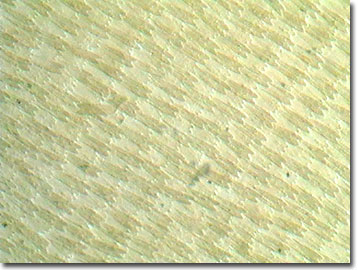Butterfly Wing Scale Digital Image Gallery
Mocker Swallowtail Butterfly
Scientifically known as Papilio dardanus, the mocker swallowtail represents a significant amount of biodiversity and polymorphism. Unusual for swallowtail butterflies, members of the mocker species initially prefer to visit blue flowers. Soon, however, they learn to feed from forest flowers of other colors, which are rich in nectar and pollen, based on observing the behavior of other butterfly species in their vicinity.

Mocker swallowtail butterflies exist in thirteen different color morphs in various areas of sub-Saharan Africa. Only the females are mimetic, however, and the males of the species display the same black and yellow warning coloration pattern regardless of geographic location. Several different genes determine a morph's color pattern, yet a single gene acts as a developmental switch for an individual female to determine its mimicry pattern. Females may be black and white, black and orange, white and orange, or black and creamy yellow, depending on their geographic locality and the butterfly species it is mimicking.
The female-limited Batesian mimicry provides the mocker swallowtail butterfly with protection from predators without the metabolic cost of manufacturing defensive and noxious chemical compounds. Female mocker swallowtails may imitate various butterflies, but chiefly mimic the poisonous friar butterfly, African queen butterfly, Pogge's wanderer butterfly, and species in the Amauris echeria group. There are some cases of gynandromorphic mocker swallowtail butterflies, which are sexual mosaics that display both male and female wing coloration and patterns, and andromorphic females, which display male wing designs. Also, a female mocker swallowtail butterfly may mate multiple times and up to three different males may fertilize her eggs.
In some regions, mocker swallowtail populations feature multiple female morphs mimicking different unpalatable species or models. By minimizing the ratio of mimetic morphs to model species, mocker swallowtail butterflies may be improving the learning curve for predator avoidance and increasing their fitness. As such, the mocker swallowtail butterfly is a favorite laboratory subject of molecular geneticists tracing DNA sequence polymorphisms, island biogeography, and disruptive selection, in which butterflies at either extreme of phenotypes are favored over those with intermediate characteristics in each population.
Contributing Authors
Cynthia D. Kelly, Shannon H. Neaves, Laurence D. Zuckerman, and Michael W. Davidson - National High Magnetic Field Laboratory, 1800 East Paul Dirac Dr., The Florida State University, Tallahassee, Florida, 32310.
BACK TO THE BUTTERFLY WING SCALE IMAGE GALLERY
BACK TO THE DIGITAL IMAGE GALLERIES
Questions or comments? Send us an email.
© 1995-2022 by Michael W. Davidson and The Florida State University. All Rights Reserved. No images, graphics, software, scripts, or applets may be reproduced or used in any manner without permission from the copyright holders. Use of this website means you agree to all of the Legal Terms and Conditions set forth by the owners.
This website is maintained by our
Graphics & Web Programming Team
in collaboration with Optical Microscopy at the
National High Magnetic Field Laboratory.
Last Modification Friday, Nov 13, 2015 at 02:19 PM
Access Count Since January 21, 2003: 9009
Visit the website of our partner in introductory microscopy education:
|
|
